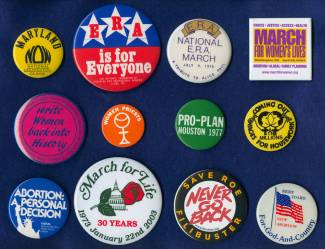Collection Name
About
In January 1973, in a landmark case known as Roe v. Wade, the United States Supreme Court ruled that abortions are permissible for any reason a woman chooses (up until a certain point), and are also permissible after that point if necessary for the protection of the woman's health. The Court based this upon the constitutional right to privacy under the 14th Amendment.
In the wake of this decision several organizations, such as the National Right to Life Committee which was founded in 1973, were formed to affect a Pro-Life public policy. To annually commemorate what was felt to be an "infamous abortion decision" by the Supreme Court, a March for Life Committee was established and on January 22, 1974 the first "March for Life" was held in Washington DC and attended by 20,000 people. This annual right-to-life rally and march has grown each year with approximately 100,000 participating in the 2003 March represented by the button depicted here.
The National Association for the Repeal of Abortion Laws (NARAL) was founded in 1969. Upon the passage of legalized abortion in 1973, it became known as the National Abortion Rights Action League whose button is depicted here from about 1980. It later became the National Abortion and Reproductive Rights Action League, with the name finally changed in 2003 to NARAL Pro-Choice America. This is the organization's effort to emphasize that the issue more correctly centers on a woman's right to choose. The organization continues to work on behalf of pro-abortion legislative, public policy, and judicial issues on the state and federal levels.
On April 25, 2004 the National Organization for Women, NARAL Pro-Choice America, Planned Parenthood and others sponsored the largest demonstration and march in American history. This was the "March for Women's Lives", represented in the button above, and which attracted between 800,000 and 1.5 million people to the National Mall in Washington DC. The rally participants focused upon the issues of abortion rights, pro-choice, and reproductive freedom. The participants would march along Pennsylvania Avenue where counter-demonstrators, numbering a few hundred, lined a portion of the route. Chief among these were members of Operation Witness, an anti-abortion group founded in 1986.
In November 1977, the National Women's Conference was held in Houston, Texas. This Conference is felt to be the first national meeting of its type since the Seneca Falls, New York Women's Rights Convention in 1848. The conference was preceded by a series of local grassroots and statewide meetings held throughout the country. These were directed toward developing a draft National Plan of Action which was focused upon improving the lives of women. This Plan would eventually be approved and adopted. Included within the Plan were planks pertaining to Child Care, Child Abuse, Employment, Health, Battered Women, the Equal Rights Amendment (ERA), Sexual Preference, and Reproductive Freedom. Several of the more controversial of these served as a rallying point for those in opposition to what many considered a feminist ideology.
In 1965 the United States Equal Employment Opportunity Commission (EEOC) upheld the segregated employment practice of advertising separately for "Help Wanted Male" and "Help Wanted Female" job notices. Many saw this as job discrimination and it became a basis for the establishment of the National Organization for Women (NOW) in 1966. Betty Friedan (1921-2006), a co-founder of NOW, served as its first president from 1966 to 1970, and is credited with actually coming up with the acronym, "NOW". Abortion rights, violence against women, lesbian rights, and sexual discrimination are among NOW's primary public policy issues.
The Episcopal Women's Caucus was founded in 1971 and had as one of its goals the ordination of women. The caucus exists today in its effort to promote the role and status of women in the Episcopal Church. It was in 1974 that several Bishops of the Episcopal Church, USA "irregularly" ordained eleven women as priests. They became known as the "Philadelphia Eleven". However, it would not be until 1976 that the church officially passed a resolution allowing female ordination. The women ordained in 1974 were "regularized" in 1977, and over 100 women were ordained by the end of the year. The Roman Catholic Church, primarily on theological grounds, still excludes women from the priesthood, and several Christian Protestant denominations still remain divided on the issue.
Should a housewife be paid wages? Is a homemaker a wage-earning laborer? Selma James, a former factory-worker, housewife, mother, and writer thought so and as such in 1972 founded the Wages for Housework Campaign. Quite simply, the Campaign believes that working in the home, as well as in the community, fulfills a critical role in support of the nation's economy and society. And as such this work should be measured, valued, and financially compensated in the form of wages paid by the government. The button depicted here is one of several which resulted as a direct outgrowth of this issue during the 1970s and throughout the 1980s.
In 1923, the suffragette leader, Alice Paul (1885-1977), wrote the Equal Rights Amendment (ERA). Paul had earlier founded the National Woman's Party in 1913 and along with others had worked hard toward the ratification of the 19th Amendment to the Constitution in 1920 which affirmed a woman's right to vote. Alice Paul felt that the next step was an amendment guaranteeing "equality of rights" under the Constitution to both women and men. This was the basis for the ERA. The ERA has been introduced in each session of Congress since 1923. It was passed in 1972 and sent to the States for ratification. In 1982, the deadline for ratification, it came up three states short of the 38 required for ratification. Among the ERA pins depicted here is one from the National ERA March held in Washington, DC on July 9, 1978. Over 100,000 people attended this event (see photo of Al Feldstein with Gloria Steinem).
